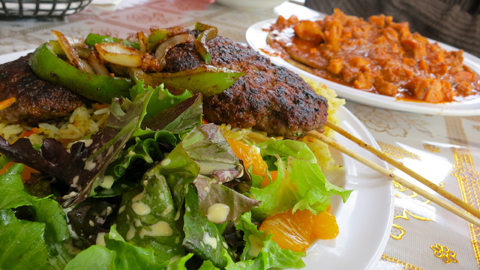
FLAVORS OF THE HORN OF AFRICA Somalian dishes at Al Huda. |
The long coastline of Somalia is at the root of its culture's many complexities. It is also the source of the strange and wonderful variety of its cuisine. It is a style too rarely on offer in its full splendor here in Maine, which has benefited from an influx of Somali immigrants, and many Somali markets, but few lasting Somali restaurants. The new Al Huda on Morrill's Corner, next to the Banadir Halal Market, has the potential to change that. This is mostly thanks to its expert preparation of a nice variety of Somali dishes, but also because of the warmth of the welcome one receives there.
Warm welcome is an important part of Somali culture, necessitated in part by many centuries in which Somalia's coastline has invited to world to it, while sending Somali sailors and traders out. It was the endless variety of life on the sea that inspired Melville to exclaim "Ah the world! Oh the world!" Somali cuisine can have a similar effect — delightfully incorporating elements of the Indian, Arabic, Turkish, East African, North African, and Italian.
Like Somalia, Al Huda exists at a busy crossroads — but not the most hospitable one: a much-trafficked intersection on outer Forest Avenue. The large dining room is scrappy, and its orange-red walls that can look a bit garish when sunlight streams through the big windows. A long purple curtain sets aside the back of the room. Embroidered polyester clothes cover tables surrounded by industrial but comfortable chairs.
It's not the most auspicious space. But it's not bad, and space-schmace — as Melville described regarding Ishmael's meal at the Try Pots: "a warm savory steam from the kitchen served to belie the apparently cheerless prospect before us." The dishes that emerge from Al Huda's kitchen brighten things up immediately.
Take for instance the chapati, in which three layers of the Indian flatbread were topped with organic chicken stewed in a yogurty tomato sauce. When they sometimes call pasta sauce "gravy," this is what they mean — it was deeply rich, expertly spiced, and somehow meaty without any meat beyond the chicken, which was ample and incredibly tender. The whole thing was like some sort of huge divine bruschetta. The top layer of bread soaked up the gravy, while the bottom kept its soft, flakey chew.
The beef kabob is also terrific: dark seared and juicy with plenty of seasoning in the form of green onion, cumin and garlic. They are served with aromatic basmati rice — saffron yellow and perfectly chewy-soft. A gorgeous tilapia dish features big pieces of the fish, pan-fried in a reddish blend of mild chilies — served over the same rice along with a mix of vegetables and olives. The fry is expertly done, and the spicy crunch of the dark edges contrasts nicely with the tender flesh of the thicker sections of fish. Another entrée of chicken stew resonates with the sour-sweet of tomato and the slightly bitter quality that green-pepper brings to a broth.